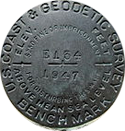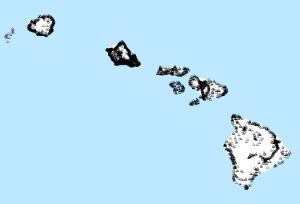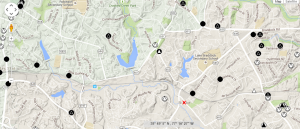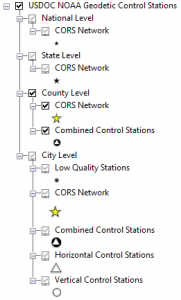How To Find Geodetic Survey Markers Canada

What Are Survey Criterion Monument Locations?
Survey benchmark monuments are brass or metal disks in the footing that provide latitude, longitude or orthometric tiptop.
They requite surveyors a point of reference considering they utilize them every bit office of a set of survey observations.
Some benchmarks also provide a reference for elevations. These types of benchmarks indicate the tiptop above or below sea level at that location.
A "benchmark" is a generic term sometimes referred as survey marks, geodetic marks and control stations. Each has a slight difference in meaning.
However, survey professionals prefer the terms station or mark rather than benchmark to describe horizontal control marks.
Developing a Datum Using Triangulation
 Example of a survey benchmark monument. More recently, survey markers are now often used to gear up a GPS receiver antenna in a known position for use in Differential GPS surveying.
Example of a survey benchmark monument. More recently, survey markers are now often used to gear up a GPS receiver antenna in a known position for use in Differential GPS surveying.
In surveying and mapping of large areas, the curvature of the surface of the Earth and bounding main-level surface must exist taken into consideration. This is why geodetic surveys extending across North America accept been developed. They serve as a ground for North America'due south horizontal control data.
With 2 criterion locations, triangulation and trigonometry are used to measure out the direction, distance, and height between them. This is called geodetic leveling. Geodetic leveling tin even be used to sympathize the area and volume of the World.
Horizontal control data provide a rigid framework for map makers, engineers, and land surveyors in North America. It makes it possible for greater precision for surveys and to locate national, country, county, and private boundaries with greater precision. Benchmarks are important to surveyors because they assistance accurately measure the positions of all land boundaries and mod infrastructure.
Who is Responsible for Survey Benchmark Monuments?
In the Us, NOAA's National Geodetic Survey (NGS) is responsible for managing approximately 240,000 stations gathered over the concluding two centuries. This survey benchmark information is fabricated available through the National Geodetic Survey Information Explorer.
NGS adult the North American Datum of 1927 that was defined by the Clarke spheroid of 1866, with its origin at (the survey station) Meade'south Ranch. A more accurate datum was created called Northward American Datum of 1983 (NAD 83). This horizontal control datum is used in the U.s., Canada, Mexico, and Cardinal America, based on a geocentric origin and the Geodetic Reference Organization 1980.
- In Canada, Natural Resources Canada's Geodetic Reference System is responsible for the maintenance of survey benchmarks.
- United Kingdom's maintenance of benchmarks is provided by the Ordnance Survey
- In French republic, it'due south Institut Géographique National.
What Types of Benchmarks Exist?

Two master types of benchmarks exist – "vertical control points" and "horizontal control points".
- Vertical control points comprise a precisely measured orthometric height. The elevation is commonly measured as summit above body of water level.
- Horizontal control points simply comprise latitude and longitude values.
Within these ii broad types of survey benchmarks, at that place are dissimilar types of categories for horizontal command markers equally described in NOAA'southward Horizontal Control documentation.
INTERSECTION STATIONS are horizontal command marks with landmarks that can exist seen from a distance. Examples of intersection stations are water or radio towers. These points tin can be observed with a telescope using trigonometry to determine their position on Earth.
TRIANGULATION STATIONS are markers with positions determined by measuring distances and angles from other stations. Reference marks assist go along triangulation stations from being lost with arrows on their disks pointing in the direction of their referenced triangulation station. Azimuth marks, coupled with its triangulation station, provides a compass management of the truthful north (which is different from the magnetic north).
NOAA Geodetic Control Points Data Explorer

In that location are approximately 240,000 stations gathered over the last two centuries in the United States. This data is made available through the National Geodetic Survey Data Explorer.
From coast-to-coast dating back to 1832, benchmarks take been surveyed using a range of different techniques. Surveyors installed survey benchmarks systematically beyond the region. New distances and angles were always existence recorded between points.
Each survey criterion is stored in the NGS database with its ain unique personal identifier (PID) half-dozen-character alphanumeric lawmaking, latitude, and longitude. Many have scaled positions from maps.
Types of NOAA Control Points
The National Geodetic Survey Data Explorer shows geodetic command stations maintained by the National Oceanic and Atmospheric Administration (NOAA), National Geodetic Survey.
Here are the various types of NOAA control points:

CONTINUOUSLY OPERATING REFERENCE STATIONS (CORS) NETWORK are control stations with permanently operating Global Positioning System (GPS) receivers. In the NOAA command point dataset, they are identified by the attribute DATUM_TAG = '(CORS)'.
COMBINED CONTROL STATIONS are horizontal and vertical command stations.
Depression QUALITY STATIONS have low quality latitude, longitudes (horizontal) and/or depression quality Orthometric Heights (vertical). Low horizontal quality have the post-obit attributes: POS_SRCE = 'GPS_OBS', 'NO Bank check', 'HD_HELD1', 'HD_HELD2', or 'SCALED'. Low vertical quality have the following attributes: "ELEV_SRCE" = 'GPSCONLV ', 'VERT ANG', 'H LEVEL', 'VERTCON', or 'SCALED'.
HORIZONTAL Command STATIONS just contain precise latitudes and longitude. They the attribute POS_SRCE = 'ADJUSTED'.
VERTICAL CONTROL STATIONS have precise Orthometric Heights which measure elevation in meters indicating the height higher up the Geoid. They have the following attributes: ELEV_SRCE = 'Adapted', 'ADJ UNCH', 'POSTED', 'READJUSTED', 'Due north HEIGHT', 'RESET', 'GPS OBS(2006', 'LEVELING'), or 'LEVELING(200)'.
Note: A single station can exist classified in multiple ways – equally an example having low-quality Orthometric Height and be part of the CORS network.
Geocaching for Survey Monuments (Benchmarking)

The term "benchmark hunting" refers to the hobby of geocaching for historical survey benchmarks. Survey benchmark hunting has carved out its own niche in this exciting hobby.
Why do geocachers seek survey benchmark points?
When you search for a survey benchmark, you really get to come across a piece of history. Some of these points haven't been visited for decades, fifty-fifty centuries. When y'all find these hidden gems placed into the ground years ago, they tin can exist documented and shared with the geocaching customs. And you have bragging rights in the community.
There's a lot of buzz around benchmarks in the geocaching community because there's most a hidden history behind them.
When you lot discover a survey benchmark, you may exist looking at a benchmark surveyed more than a century ago.
Seek out the nearest survey monument to you. Geocache and observe the history of classical surveying.
References
Geodetic Survey Benchmark – Image Courtesy of National Oceanic and Atmospheric Administration and the Section of Commerce
Subscribe to our newsletter:
Source: https://gisgeography.com/survey-benchmark-monument-location-geocache/
Posted by: gravescolmilluke.blogspot.com


0 Response to "How To Find Geodetic Survey Markers Canada"
Post a Comment